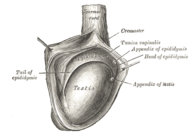- Epididymis
-
Epididymis 
1: Epididymis
2: Head of epididymis
3: Lobules of epididymis
4: Body of epididymis
5: Tail of epididymis
6: Duct of epididymis
7: Deferent duct (ductus deferens or vas deferens)
The right testis, exposed by laying open the tunica vaginalis. Gray's subject #258 1242 Vein Pampiniform plexus Precursor Wolffian duct MeSH Epididymis The epididymis (
 /ɛpɨˈdɪdɨmɪs/; plural: epididymides /ɛpɨˌdɪdɨˈmiːdiːz/) is part of the male reproductive system and is present in all male amniotes. It is a narrow, tightly-coiled tube connecting the efferent ducts from the rear of each testicle to its vas deferens. A similar, but probably non-homologous, structure is found in cartilaginous fishes.
/ɛpɨˈdɪdɨmɪs/; plural: epididymides /ɛpɨˌdɪdɨˈmiːdiːz/) is part of the male reproductive system and is present in all male amniotes. It is a narrow, tightly-coiled tube connecting the efferent ducts from the rear of each testicle to its vas deferens. A similar, but probably non-homologous, structure is found in cartilaginous fishes.Contents
Regions
The epididymis can be divided into three main regions
- The head (Caput). The head of the epididymis receives spermatozoa via the efferent ducts of the mediastinum of the testis. It is characterized histologically by a thin myoepithelium. The concentration of the sperm here is dilute.
- The body (Corpus)
- The tail (Cauda). This has a thicker myoepithelium than the head region, as it is involved in absorbing fluid to make the sperm more concentrated.
In reptiles, there is an additional canal between the testis and the head of the epididymis, which receives the various efferent ducts. This is, however, absent in all birds and mammals.[1]
Histology
The epididymis is covered by a two layered pseudostratified epithelium. The epithelium is separated by a basement membrane from the connective tissue wall which has smooth muscle cells. The major cell types in the epithelium are:
- Principal cells: columnar cells that, with the basal cells, form the majority of the epithelium. These cells cells extend from the lumen to the basal lamina,[2] They also have non-motile stereocilia, which are long and branching in the head region and shorter in the tail region.[2] They also secrete carnitine, sialic acid, glycoproteins, and glycerylphosphorylcholine into the lumen.
- Basal cells: shorter, pyramid-shaped cells which contact the basal lamina but taper off before their apical surfaces reach the lumen.[2] These are thought to be undifferentiated precursors of principal cells.[2]
- Apical cells: predominantly found in the head region[2]
- Clear cells: predominant in the tail region[2]
- Intraepithelial lymphocytes: distributed throughout the tissue.[2]
Role in storage of sperm and ejaculant
Spermatozoa formed in the testis enter the caput epididymis, progress to the corpus, and finally reach the cauda region, where they are stored. Sperm entering the caput epididymis are incomplete - they lack the ability to swim forward (motility) and to fertilize an egg. During their transit in the epididymis, sperm undergo maturation processes necessary for them to acquire these functions.[3] Final maturation is completed in the female reproductive tract (capacitation).
During ejaculation, sperm flow from the lower portion of the epididymis (which functions as a storage reservoir). They have not been activated by products from the prostate gland, and they are unable to swim, but are transported via the peristaltic action of muscle layers within the vas deferens, and are mixed with the diluting fluids of the seminal vesicles and other accessory glands prior to ejaculation (forming semen).
The epithelial cells of the epididymis possesses numerous apical modifications that are often referred to as stereocilia, as under the light microscope they look like cilia. However, as electron microscopy has revealed them to be structurally and functionally more similar to microvilli, some now refer to them as stereovilli.[4]
Pathology
An inflammation of the epididymis is called epididymitis. It is much more common than orchitis.
Embryology and vestigial structures
A Gartner's duct is a homologous remnant in the female.
In the embryo, the epididymis develops from tissue that once formed the mesonephros, a primitive kidney found in many aquatic vertebrates. Persistence of the cranial end of the mesonephric duct will leave behind a remnant called the appendix of the epididymis. In addition, some mesonephric tubules can persist as the paradidymis, a small body caudal to the efferent ductules.
Epididymectomy
Epididymectomy is the surgical removal of the epididymis sometimes performed for Post-Vasectomy Pain Syndrome.
Gallery
-
Micrograph of an epididymis. H&E stain.
Notes
- ^ Romer, Alfred Sherwood; Parsons, Thomas S. (1977). The Vertebrate Body. Philadelphia, PA: Holt-Saunders International. pp. 394–395. ISBN 0-03-910284-X.
- ^ a b c d e f g Kierszenbaum, Abraham L. (2002). Histology and cell biology : an introduction to pathology. St. Louis [u.a.]: Mosby. pp. 556. ISBN 0-323-01639-1.
- ^ Jones R (1999). "To store or mature spermatozoa? The primary role of the epididymis". Int J Androl 22 (2): 57–67. doi:10.1046/j.1365-2605.1999.00151.x. PMID 10194636. abstract
- ^ Ross, Michael H.; Pawlina, Wojciech (2011). Histology: A Text and Atlas. Lippincott Williams & Wilkins. pp. 110–112. ISBN 978-0-7817-7200-6.
External links
- Histology at BU 16903loa
- inguinalregion at The Anatomy Lesson by Wesley Norman (Georgetown University) (testes)
Male reproductive system (TA A09.3–4, TH H3.07.02, GA 11.1236) Internal layers (Tunica vaginalis, Tunica albuginea, Tunica vasculosa testis) · Appendix · Mediastinum · Lobules · Septa · Leydig cell · Sertoli cell · Blood-testis barrierOtherSeminiferous tubules (Tubuli seminiferi recti, Rete testis, Efferent ducts) · Epididymis (Appendix, Stereocilia) · Paradidymis · Spermatic cord · Vas deferens (Ampulla) · Ejaculatory ductAccessory
glandsExternal root (Crus, Bulb, Fundiform ligament, Suspensory ligament) · body (Corpus cavernosum, Corpus spongiosum) · glans (Foreskin, Frenulum, Corona) · fascia (superficial/subcutaneous, deep/Buck's) · Tunica albuginea · Septum of the penisCategories:- Male reproductive system
Wikimedia Foundation. 2010.





